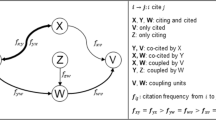Abstract
Like the citation network of scientific publications, the Web is also a graph where pages are connected together by hypertext links or “sitations”. In the new research field Webometrics, scholars have investigated equivalencies between citationist concepts established in bibliometrics and hyperlinks networks. This paper focuses on the possible analogy between co-citation and co-sitation to structure Web universes. It reports an experiment in the field of bibliometrics and scientific indicators. Several technical aspects that must be dealt with are reviewed. Co-sitation seems a promising way to delineate topics on the Web. However, the analogy with traditional co-citation is deeply misleading: many precautions must be taken in the interpretation of the results.
Similar content being viewed by others
References
Aguillo, I. (1999), Statistical Indicators on the Internet: The European Science-Technology-Industry System in the World-Wide Web, at: http://diotima.math.upatras.gr/weborg/aguillo2
Boudourides, M., B. Sigrist, P. Alevizos (1999), Webometrics and Self-Organization of the European Information Society, at: http://hyperion.math.upatras.gr/webometrics
Braam, R. R., H. F. Moed, A. F. J. Van Raan (1991), Mapping of science by combined co-citation and co-word analysis, II. Dynamical aspects, Journal of the American Society of Information Science, 42: 252–266.
Brin, S., L. PAGE (1998), The anatomy of a large-scale hypertextual Web search engine, Proceedings of the 7 th International World Wide Web Conference, 1998.
Bar-Ilan, J. (2001), How much information the search engines disclose on the links to a Web Page ? A case study of the “Cybermetrics” home page, Proceedings of the 8 th International Conference on Scientometrics and Infometrics, ISSI 2001, Sydney, Australia, July 16–20, 2001, pp. 63–73.
Bj Ö rneborn. L., P. INGWERSEN (2001), Perspectives of Webometrics, Scientometrics, 50 (1): 65–82.
DUBLIN CORE PROJECT (1999), Dublin Core Metadata Element Set, Version 1.1: Reference Description, at: http://dublincore.org/documents/dces/
Egghe, L. (2000), New informetric aspects of the Internet: Some reflections, many problems, Journal of Information Science, 26 (5): 329–335.
Garfield, E. (1972), Citation analysis as a tool in journal evaluation, Science, 178: 471–479.
GlÄnzel, W., U. SCHOEPFLIN (1994), A stochastic model for the aging of scientific literature, Scientometrics, 30 (1): 49–64.
Ingwersen, P. (1998), The calculation of web impact factors, Journal of Documentation, 54: 236–243.
Kessler, M. M. (1963), Bibliographic coupling between scientific papers, American Documentation, 14: 10–25.
Kleinberg, J. (1999), Authoritative sources in a hyperlinked environment, Journal of the ACM, 46: 604–632.
Kosala, R., H. BLOCKEEL (2000), Web mining research: A survey, SIGKDD Explorations, 2: 1–15.
Kumar, R., P. Raghavan, S. Rajagopalan, A. Tomkins (1999), Trawling the Web for emerging cyber-communities, In the Proceedings of the Eighth World Wide Web Conference.
Larson, R. (1996), Bibliometrics of the world wide web: An exploratory analysis of the intellectual structure of the cyberspace, In: Proceedings of the Annual Meeting of the American Society of Information Science, (Baltimore, Md., Oct. 19–24, 1996).
Leydesdorff, L. (1997), Why words and co-words cannot map the development of the sciences, Journal of the American Society for Information Science, 48 (5): 418–427.
Mannina, B., L. Quoniam, Cybermetrics, 4(1) paper 1. [OnLine] at: http://www.cindoc.csic.es/cybermetrics/articles/v4i1p1.html
Marshakova, I. V. (1973), Document coupling system based on references taken from Science Citation Index (in Russian), Nauchno–Tekhnicheskaya Informatsiya, Ser. 2 (6): 3.
Pinski, G., F. Narin (1976), Citation influence for journal aggregates of scientific publications: Theory, with application to the literature of physics, Information Processing and Management, 12: 297–312.
Pitkow, J., P. Pirolli (1997), Life, death and lawfulness on the electronic frontier, In: Proceedings of the ACM SIGCHI Conference on Human Factors in Computing System (CHI'97), ACM New York, pp. 118–125.
Price, D. J. DE S. (1976), A general theory of bibliometric and other cumulative advantage processes, Journal of the American Society for Information Science, 27: 292–306.
Rip, A. (1988), Mapping of science: Possibilities and limitations, In: Handbook of Quantitative Studies of Science and Technology, A. F. J. Van Raan (Ed.), Elsevier Science Publishers, Amsterdam, 253–273.
Rousseau, R. (1997), Sitations: an exploratory study, Cybermetrics, 1: 1. at: http://www.cindoc.csic.es/cybermetrics/articles/v1i1p1.html
Savoy, J. (1996), Citation schemes in Hypertext information retrieval, In: Agosti, M., Smeaton, A. (Eds), Information Retrieval and Hypertext, Kluwer, pp. 99–120.
Savoy, J., J. Picard (2000), Recherche documentaire sur le web: Les hyperliens sont-ils vraiment utiles ? Actes JADT2000, 27–34.
Small, H. G. (1973), Co-citation in the scientific literature, Journal of the American Society for Information Science, 24: 265–269.
Small, H. G., Griffith, B. C. (1974), The structure of scientific literature 1&2, Science Studies, 17–40 and 265–269.
Small, H. G., E. SWEENEY (1985), Clustering the Science Citation Index using co-citation. I. A comparison of methods, Scientometrics, 7: 391–409.
Small, H. G., E. Sweeney, E. Greenlee (1985), Clustering the Science Citation Index using co-citation. II. Mapping science, Scientometrics, 8: 321–340.
White, H. D., B. C. GRIFFITH (1981), Author co-citation: A literature measure of intellectual structure, Journal of the American Society for Information Science, 32: 163–172.
White, H. D., K. W. McCain (1989), Bibliometrics. In: Annual Review of Information Science and Technology, 24: 119–186. Elsevier, Amsterdam.
Wouters, P., R. De Vries (2001), Formally Citing the Web, at: http://home.pscw.uva.nl/lleydesdorff/avril/April2001/wouters.htm
Zitt, M., E. Bassecoulard (1994), Development of a method for detection and trend analysis of research fronts built by lexical of cocitation analysis, Scientometrics, 30: 333–351.
Zitt, M., E. Bassecoulard (1996), Reassessment of co-citation methods for science indicators: Effect of methods improving recall rates, Scientometrics, 37: 223–244.
Zitt, M., E. Bassecoulard (1998), Méthodes de structuration pour l'analyse stratégique des univers scientifiques: les techniques de citation, Veille Stratégique, Scientifique et Technologique, Actes VSST'98, Toulouse, France, 19–23 oct.1998, pp. 31–41.
Author information
Authors and Affiliations
Rights and permissions
About this article
Cite this article
Prime, C., Bassecoulard, E. & Zitt, M. Co-citations and co-sitations: A cautionary view on an analogy. Scientometrics 54, 291–308 (2002). https://doi.org/10.1023/A:1016022214005
Issue Date:
DOI: https://doi.org/10.1023/A:1016022214005




